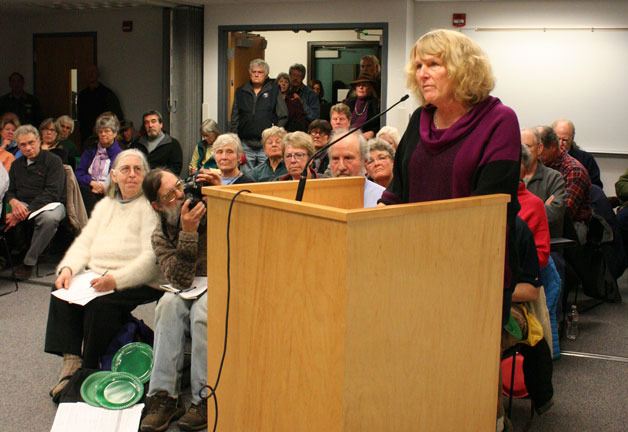The Island County commissioners voted unanimously in favor of continuing the Conservation Futures program Monday after hundreds of residents contacted them in support over the last week.
More than 100 people attended the Monday meeting, giving nearly two hours of public comment. All but a few speakers favored the continuation of the conservation futures levy. Many said they’d like to see an increase to the tax, which costs property owners roughly $35 per year and is expected to bring in $679,814 in 2014.
“It’s interesting that we have a packed house,” said Al Williams during the public hearing. “There’s bigger value in life than a dollar sign.”
“I believe it is exceptionally important to my generation,” said teenager Rocco Strain. “As the voice of the future, I believe in continually protecting and maintaining the resources we have.”
The board had initially intended to consider placing the program on hold for one year, and reducing the levied amount from $679,814 — the amount collected this year — to $439,238.
“It’s seems like if you cut a program it’s because it’s not popular or it’s not efficient,” said Dean Enell, who said he has served on citizens advisory boards for the futures fund. “This runs better than any government effort I’ve ever seen.”
Commissioner Kelly Emerson proposed an amendment to the ordinance, outlining the county’s priorities for the futures fund. The board agreed that purchasing easements surrounding NAS Whidbey and OLF would be a top priority, followed by a loan payoff and continued debt service payments, applications for maintenance of existing properties and new easements throughout the county.
Emerson described the open space that she enjoyed as a child in California, and said the area has since been developed into a “beautiful” marina that has created a lot of jobs. She said she believes there are benefits to development of these kinds of areas.
Emerson said she has heard support from some constituents for a moratorium on the Conservation Futures Fund, adding that she maintains the issue should be taken to the public for a vote.
“It is popular? Maybe it is. I don’t know,” Emerson said. “I still question, which is why I think it should go to a vote of the people.”
That said, Emerson said she would be willing to support the current funding levels, without the optional 1 percent increase, if the board would establish “specific priorities within the language of the ordinance.”
After some haggling on the wording of the amendment, the other two commissioners conceded and the ordinance passed 3-0.
Commissioner Helen Price Johnson said Tuesday the ordinance didn’t go “as far” as she would have liked, but she considered the compromise a success.
“I would have liked us to maintain the funding with the 1 percent increase,” Price Johnson said. “But it’s a really important win.”
The move to prioritize areas surrounding working airfields on Whidbey highlights the hotbed of tension there. Resident complaints about jet noise have increased over the past year. Many believe that the EA-18G Growler is louder than the EA-6B Prowler it is replacing, and that the Navy is performing more operations than estimated in a 2005 study.
The Citizens of Ebey’s Reserve or COER, who sued the Navy in July asking for an environment impact study due the complaints of excessive jet noise, issued the following statement Tuesday.
“While COER is appreciative of the fact that the county and the Navy are finally admitting that the EA-18G is causing physical and mental harm to residents living under the horrific noise of EA-18Gs at the OLF, COER does not feel that taking any funds away from the conservation futures of the entire county is the proper thing to do. COER is not in any way seeking a financial conclusion to the problem of the noise generated by the jets at the OLF. COER feels that the only solution is stopping the EA-18G from using the Coupeville OLF.”
Commissioner Jill Johnson said she was glad to see all the community input even though many were vocally against her idea to place the futures program on hold.
“It cuts both ways,” Johnson said. “But I’m glad when people participate. Everyone was respectful and good points were raised. These should be high-turnout conversations. This is really a battle of values and people need to be engaged on this.”
According to state law, the county can borrow money to purchase “any open space land, farm and agricultural land, and timber land” to control the development rights. The private owner may retain the right to continue any existing open space use of the land, and to develop any other open space use, but only under conservation futures restrictions defined by the county.
The county issues a tax levy to pay the debt service for the acquired land or development rights.



